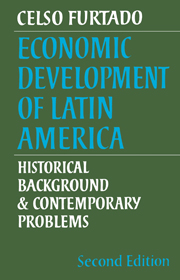Book contents
- Frontmatter
- Contents
- Tables
- Preface to the second edition
- Preface to the first edition
- Abbreviations
- Maps
- PART ONE FROM THE CONQUEST TO THE FORMATION OF NATION-STATES
- PART TWO ENTRY INTO THE SYSTEM OF INTERNATIONAL DIVISION OF LABOUR
- PART THREE THE TRADITIONAL STRUCTURAL PATTERN
- PART FOUR CHARACTERISTICS OF THE INDUSTRIALISATION PROCESS
- PART FIVE REORIENTATION OF DEVELOPMENT IN THE RECENT PERIOD
- PART SIX INTERNATIONAL RELATIONS
- PART SEVEN INTRA-REGIONAL RELATIONS
- 20 Integration process in Central America
- 21 LAFTA and the Andean Group
- PART EIGHT STRUCTURAL RECONSTRUCTION POLICIES
- Bibliography
- Index
20 - Integration process in Central America
Published online by Cambridge University Press: 25 January 2010
- Frontmatter
- Contents
- Tables
- Preface to the second edition
- Preface to the first edition
- Abbreviations
- Maps
- PART ONE FROM THE CONQUEST TO THE FORMATION OF NATION-STATES
- PART TWO ENTRY INTO THE SYSTEM OF INTERNATIONAL DIVISION OF LABOUR
- PART THREE THE TRADITIONAL STRUCTURAL PATTERN
- PART FOUR CHARACTERISTICS OF THE INDUSTRIALISATION PROCESS
- PART FIVE REORIENTATION OF DEVELOPMENT IN THE RECENT PERIOD
- PART SIX INTERNATIONAL RELATIONS
- PART SEVEN INTRA-REGIONAL RELATIONS
- 20 Integration process in Central America
- 21 LAFTA and the Andean Group
- PART EIGHT STRUCTURAL RECONSTRUCTION POLICIES
- Bibliography
- Index
Summary
Institutional framework
As we have seen in earlier chapters, the export of primary products was the starting-point for an initial industrialisation process in many Latin American countries. However, externally induced structural change was dependent on the parallel action of domestic factors such as the relative importance of wage payment flows, the degree of domestic control over export activity, fiscal policy, the existence of a significant volume of recent immigration of European origin, etc. Among such simultaneously acting factors probably none was quite so important as the size of the country, if we take this to mean, firstly, the relative population size and, secondly, the natural-resource base. Thus, in the case of the five Central American countries each with a population averaging just over one and a half million inhabitants in 1950, it can be said that the main cause of their relative backwardness was closely related to their small size.
The Central American isthmus, excluding the present territory of Panama - the latter was an integral part of the Viceroyalty of New Granada and remained a province of Colombia until 1903, when it seceded to become, with the help of the United States, the Republic of Panama - was governed in colonial times from the Captaincy of Guatemala and, when it broke away from Spain in 1821, was organised as a Federal Republic. The federation succumbed to centrifugal forces unleashed during the Wars of Independence and broke up into five nation-states seventeen years later.
- Type
- Chapter
- Information
- Economic Development of Latin AmericaHistorical Background and Contemporary Problems, pp. 225 - 231Publisher: Cambridge University PressPrint publication year: 1977



